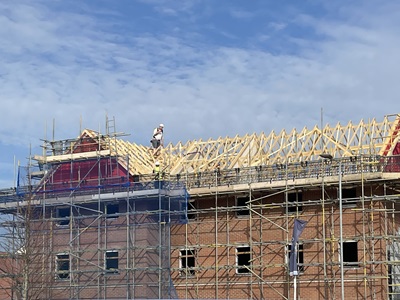New strategy aims to achieve Affordable, Available and Decent Homes
10 Sep 2024

The challenges around how a new strategy can address the affordability of housing, living conditions and homelessness in West Suffolk, are to be discussed next week.
West Suffolk Council, which is both local housing authority and the local planning authority, has already made Affordable, Available and Decent Housing one of its four strategic priorities.
Earlier this year, it asked people including residents, town and parish councils, housing associations, local NHS trusts and developers to give their views on the various challenges around housing and the actions to address them.
That has shaped a draft strategy which is to be discussed by the council’s Cabinet on Tuesday. If they approve it, the strategy will then be recommended to council to adopt when it meets in November. West Suffolk Council has already pledged over £1m to support its housing ambitions and this strategy, if approved, will see another £612,000 investment to deliver change.
“One of the biggest challenges is around homes that people can afford,” said Cllr Richard O’Driscoll, Cabinet Member for Housing at West Suffolk Council. “We need more homes that are genuinely affordable and where possible more homes available for social rent.”
Affordable housing is normally delivered through housing schemes with developers required to make 30 per cent of new housing, “affordable”.
West Suffolk Council is trying to increase that to 40 per cent on any developments built on greenfield land but that is currently with Government planning inspectors to decide, balancing up what is commercially viable.
The problem is, however, that to meet local housing needs, the council actually needs to increase the amount of affordable housing delivery to around 60 per cent of new homes – something that it cannot achieve on its own. Neither can it simply push for it through local plan policies without risking making the situation worse by jeopardising the viability and actual delivery of new housing.
Part of the issue is also what is meant by affordable housing. While it also covers shared ownership schemes, most of the time it means homes that are available to rent at 80 per cent of the cost of market rents, while social rent is around 65 per cent. The council had more than 2,500 households on its housing register for affordable housing at the beginning of September, including more than 960 in urgent or high need. But rising rents have meant even that isn’t affordable for many and has contributed to an increase in the number of households seeking council help to prevent them from becoming homeless.
“The simple fact, confirmed through our public engagement, is that we need more homes to be built in order to better balance supply against demand which is one of the factors that currently pushes up the cost of the housing market,” said Cllr O’Driscoll. “The Government is currently looking at increasing the number of homes to be delivered nationally. This could potentially see the number of homes delivered in West Suffolk each year increase from just over 800, to around 1,200 and recognising our needs, this is something I would certainly welcome.”
The strategy sets out the need to carry out greater work with housing associations who also build and run affordable housing schemes as well as working with parish councils to deliver more rural exception sites – small developments of affordable housing specifically to meet local needs. Under the strategy the council would work to maximise the different types of housing delivered as well as to unlock more difficult to develop brownfield sites such as redundant industrial and contaminated land.
“We also want to look at how we can explore the benefits that delivering more homes might achieve for our existing communities. We recognise the need to ensure new homes are the right type in the right locations with supporting infrastructure. If the strategy is approved as hoped, we will be carrying out further public engagement next year,” Cllr O’Driscoll said.
But the strategy is also about existing housing and how the council supports residents in their own homes.
“Poor housing can have a massive impact on people’s health. This strategy builds on our work to ensure decent living conditions. It includes combating fuel poverty by supporting people in low-income homes that have poor energy efficiency to make improvements, helping them heat their home for less,” Cllr O’Driscoll said. “We have already sought to address environmental improvements in new homes through the proposed Local Plan policies.
“The strategy also looks to ensure better living conditions in the private rented sector and Houses of Multiple occupation to prevent overcrowding and people living in cold, damp homes in poor disrepair.
“And it will support people as they develop health issues, to continue to be able to access and enjoy their own home rather than having to go into care or hospital which can be devastating for the individual and families.
“The strategy is also how we further our work to prevent homelessness and reduce rough sleeping.
“Our priority continues to be to try to prevent a household from becoming homeless in the first place. Where we cannot prevent this, we support households in temporary accommodation while working with them to overcome any issues before they can find a more permanent and settled home.
"Under this strategy we will look to build on our work with landlords enabling us to access more private rented sector housing to support people while continuing our work with partners to try to end rough sleeping through support and accommodation.”
You can read more on the draft Housing, Homelessness Reduction and Rough Sleeping Strategy in the West Suffolk Council Cabinet papers for 17 September 2024.
Posted in categories: press release, news
